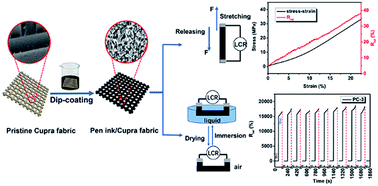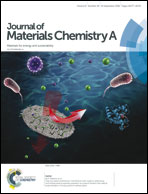Ultrasensitive and highly repeatable pen ink decorated cuprammonium rayon (cupra) fabrics for multifunctional sensors†
Abstract
Electroconductive pen ink coated cuprammonium rayon (cupra) fabrics functioning as smart materials are prepared by decorating pen ink on the surface of the cupra fabrics (CFs) by applying a facile and simple dip-coating method. The microstructure of the resultant pen ink/cupra fabrics (PCFs) is investigated by field emission-scanning electron microscopy, Raman spectroscopy and X-ray diffraction measurements, respectively. It is found that the PCFs possess not only admirable tensile strength and thermal properties, but also adjustable volume resistivities in a wide range of 1.30–0.23 kΩ cm by varying the pen ink loading. The multifunctional sensing behaviors of such novel PCFs towards stress–strain and liquid water were studied substantially. The reliable linear strain-dependent resistance void of hysteresis and high strain sensitivity render PCFs possible strain sensor candidates. In terms of liquid sensing, the PCFs exhibit a maximum relative electrical resistance change (Rrel) of about 18 800% in liquid water without degradation of sensing performance during cycling. Therefore, the PCFs with ultrahigh sensitivity and prominent repeatability as strain/liquid sensors provide a cost-effective and efficient alternative in wearable electronics and sensing applications.



 Please wait while we load your content...
Please wait while we load your content...